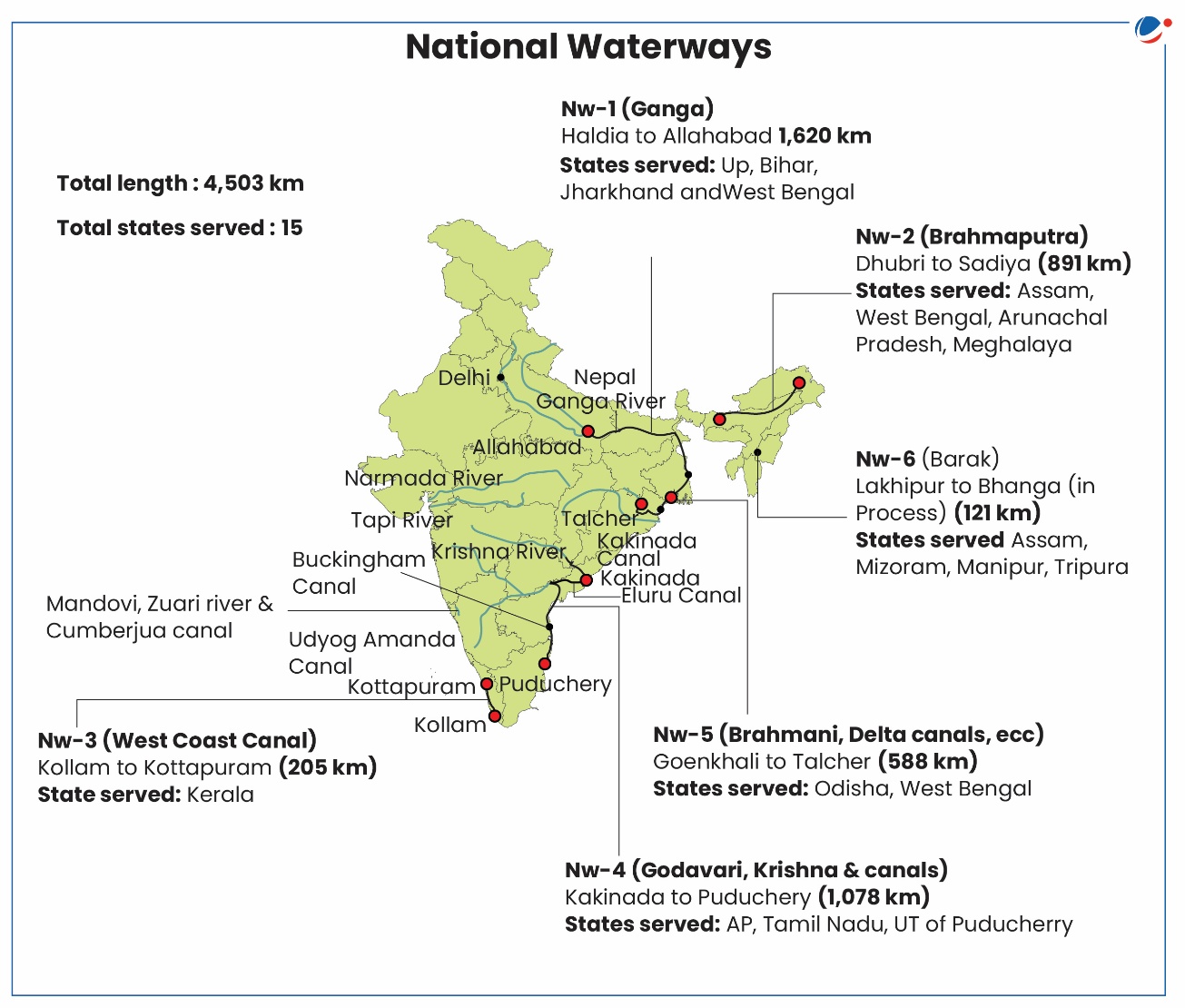
Why in the news?
The Inland Waterways Authority of India (IWAI) issued the National Waterways (Construction of Jetties/Terminals) Regulations, 2025.
About Regulations
- Formulated By: Inland Waterways Authority of India (IWAI) under the Ministry of Ports, Shipping and Waterways (MoPSW).
- Aim: To attract private sector investment in setting up terminals, streamline processes and promote efficient use of India's vast waterways network.
Key Provisions of the Regulations
- Scope: Any entity including private, wishing to develop or operate an inland waterway terminal on a national waterway.
- Both existing and new terminals, whether permanent or temporary, are covered under these regulations.
- No-objection Certificate (NoC): Any entity including private, wishing to develop or operate an inland waterway terminal on a national waterway, needs to obtain a NoC from IWAI.
- Digital Portal for Terminal Applications: To be developed by IWAI to enhance efficiency, transparency, and accessibility, for Ease of Doing Business.
- Terminal developer and operator responsibilities: They will be responsible for the technical design and construction of the terminal.
Inland Water Transport
- Definition: Inland water transport (IWT) refers to the movement of people and goods on navigable waterways like rivers, canals, lakes, and other inland bodies of water.
- Benefits:
- Fuel Efficient: 1 Litre of fuel moves 24 tonne-km on road, 95 tonne-km on rail and 215 tonne-km on IWT.
- Cost Effective: Among different transport modes, the freight cost per ton-kilometer is ₹1.36 for railways, ₹2.50 for highways, and ₹1.06 for Inland Water Transport (IWT).
- Lower infrastructure costs: Compared to building and maintaining roads and railways, inland waterways are generally cheaper to develop and upkeep needing a terminal/quay side investment mostly.
- Reduced congestion: By taking bulk goods off roads, IWT helps alleviate traffic congestion on roads and railways, improving overall supply chain efficiency.
- Lower greenhouse gas emissions: Compared to trucks, barges and other vessels used in IWT produce less air and noise pollution.
Status of Inland waterways in India
- Navigable Waterways: India has about 14,500 km of navigable waterways which comprise of rivers, canals, backwaters creeks, etc.
- About 133.03 Million Metric Tonnes (MMT) of cargo is being moved annually by Inland Water Transport (IWT).
- Comparison with Other Countries: In India, only 3.5% of trade happens through waterways, compared to 47% in China, 40% in Europe, and 35% in Bangladesh.
Initiatives Undertaken
- Inland Waterways Authority of India (IWAI): Established in 1986 is the nodal agency under the Union Ministry of Ports, Shipping and Waterways, is mandated to develop and regulate National Waterways (NWs).
- Jal Marg Vikas Project (2014): Being implemented by the IWAI with support from the World Bank to improve the navigability of the 1390 km stretch of NW1 from Varanasi to Haldia.
- Sagarmala Programme (2015): Aimed at revolutionizing India's maritime sector.
- It promotes the use of coastal and inland waterways for cargo transportation, reducing dependence on road and rail networks.
- National Waterways Act, 2016: Under it, 111 waterways (including 5 existing and 106 new) have been declared as National Waterways (NWs).
- Inland Vessels Act, 2021: Replacing Inland Vessels Act, 1917, it addresses aspects related to inland vessels including their registration, classification, pollution prevention measures, etc.
- Jalvahak Scheme (2024): Aims to encourage business enterprises with safe and timely delivery of cargo through inland waterways, in a cost-effective manner.
Major Challenges for Inland Waterways Sector in India
- Inadequate Depth: The Rivers require a minimum depth of at least 3m, but most Indian rivers are about 2 making carriage of heavy loads difficult.
- Environmental Concerns: River pollution, water flow disruption, and habitat destruction due to increased navigation.
- Shortage of IWT Vessels: Vessel buildings are highly capital-intensive and face difficulties in obtaining project finance from banks and financial institutions.
- Modal Integration: Lack of potential multimodal corridors and detailed mapping of waterways and industrial clusters, multimodal transport hubs in inland water transport corridor.
Conclusion
To unlock the full potential of inland waterways, a comprehensive and coordinated approach is essential. This includes upgrading infrastructure, promoting private investment, adopting modern technology, and ensuring multi-modal connectivity. Streamlined policies and enhanced regional collaboration will further boost cargo movement and position waterways as a key pillar of sustainable transport and trade.



